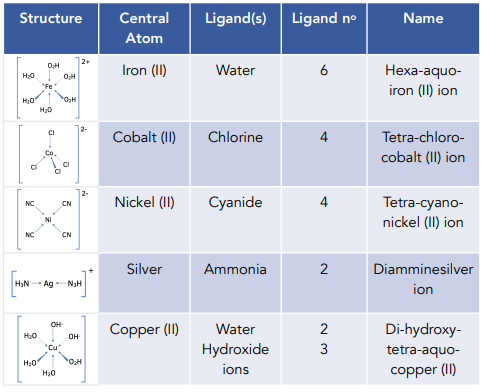Transition Metals - Introduction to Complex Ions (A-Level Chemistry)
Introduction to Complex Ions
Transition Metal Complex Ions
Complex Ion Formation
One of the properties of all transition metals is that they form complexes.
A complex is a transition metal atom or ion surrounded by molecules or ions called ligands.
Ligands form co-ordinate bonds with the transition metal by donating a pair of electrons.
A co-ordinate bond is a covalent bond in which both electrons come from the ligand.
Naming Complex Ions
The name of a complex ion has to include:
- The number of ligands – The name of a complex ion starts with the number of each particular ligand that forms covalent bonds with the central atom.
- The type of ligand – The name of the ligand will go after their number is specified. If two or more types of ligands are present, they will be named in alphabetical order.
- The central atom – The name of the central transition metal atom goes unchanged at the end. Remember to specify its oxidation number.
The following table has some examples of complex ions and their names:

Charges on Complexes
The charge on a complex depends on the oxidation state of the transition metal and the charge on the ligand.
Here you have some examples of how the charge of a complex ion is worked to:
- [Co(NH3)]³+ : The cobalt has an oxidation state of +3 and the ammonia molecules are neutral, so the overall charge is “3+”.
- [Cu(Cl)4]²- : The copper has an oxidation state of +2 and each of the four chloride ions has a charge of “-1”, so the overall charge is “2-”.
Transition Metals are a group of metals that occupy the middle of the periodic table, with atomic numbers ranging from 21 to 30, 39 to 48, and 57 to 80.
Complex Ions are ions composed of a central metal ion bonded to one or more ligands, which are usually ions or molecules with lone pairs of electrons.
A Ligand is a molecule or ion that forms a coordinate bond with a central metal ion, typically through a lone pair of electrons.
Coordination Number is the number of ligands attached to the central metal ion in a complex ion.
A Dative Covalent Bond is a covalent bond where both electrons in the bond come from the same atom, typically a lone pair on the ligand.
A Chelate Complex is a complex ion that contains a central metal ion bonded to a ligand with more than one coordinating atom, forming a ring-like structure.
A Monodentate Ligand is a ligand that donates only one pair of electrons to the central metal ion.
A Bidentate Ligand is a ligand that donates two pairs of electrons to the central metal ion through two coordinating atoms.
A Polydentate Ligand is a ligand that donates more than two pairs of electrons to the central metal ion through multiple coordinating atoms.
A Complex Ion Formula is a shorthand notation that describes the composition of a complex ion, with the central metal ion listed first, followed by the ligands enclosed in square brackets. The overall charge of the complex ion is indicated by a superscript.
A Ligand Substitution Reaction is a reaction in which one or more ligands on a complex ion are replaced by different ligands.
The Colour of Complex Ions arises from the absorption of specific wavelengths of visible light by the d-electrons of the central metal ion in the complex ion. The colour of a complex ion depends on the nature of the ligands, the coordination number, and the oxidation state of the central metal ion.
Crystal Field Theory is a model that explains the colour and magnetic properties of transition metal complexes in terms of the interaction between the d-electrons of the central metal ion and the electric field produced by the ligands.
The Spectrochemical Series is a list of ligands arranged in order of their ability to cause d-orbital splitting in a complex ion. The order of the ligands in the series determines the colour and magnetic properties of the complex ion.





Still got a question? Leave a comment
Leave a comment